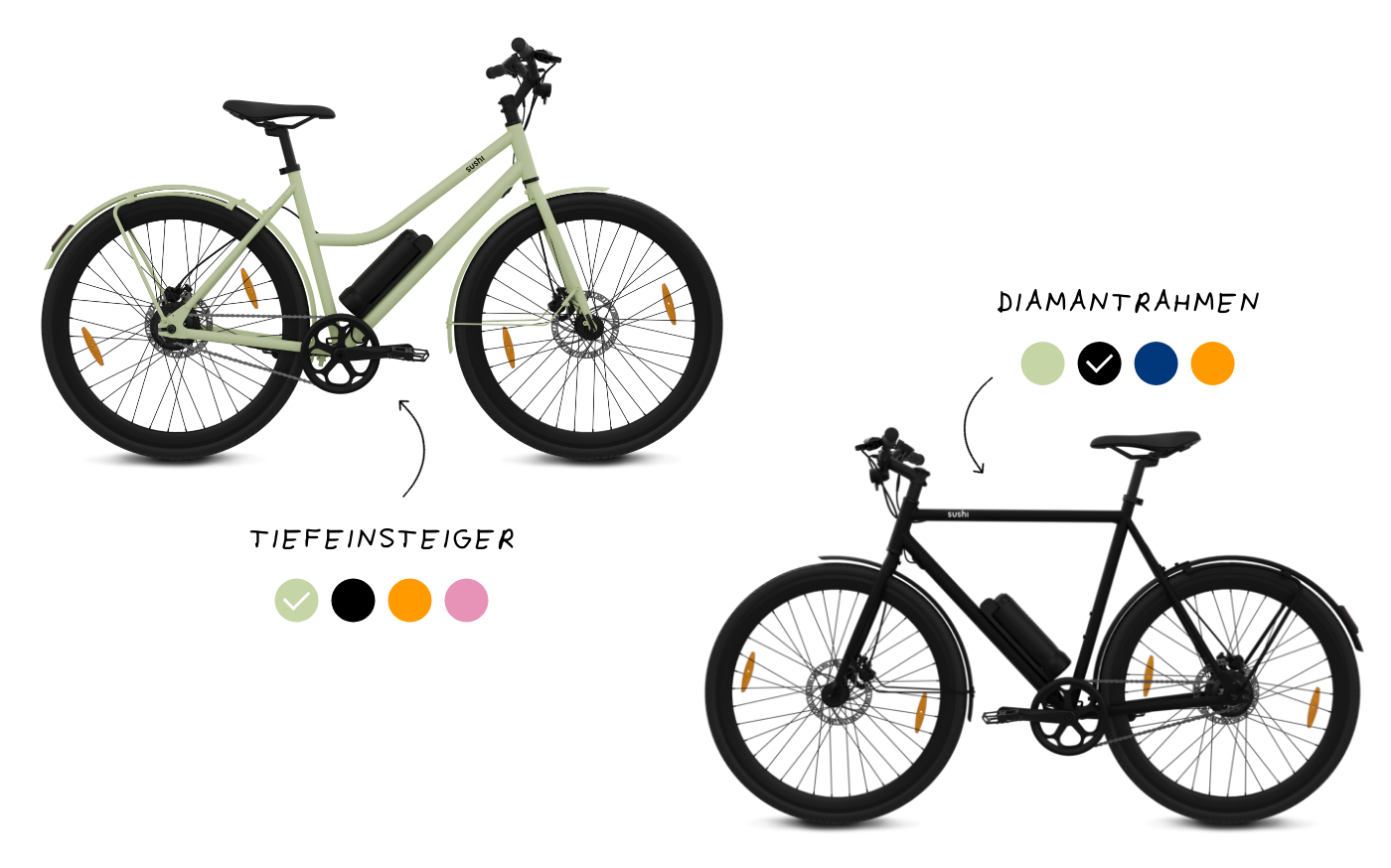Icy adventures: Tips for safe e-bike riding in the cold season
Ready for icy adventures on your SUSHI BIKE? We have the best tips to keep you safe and warm as you cycle through the cold season. Learn how to winterize your e-bike and what clothing and gear you need to be well-equipped for snow and cold.
- Preparation: Checklist for a safe e-bike
Before you hop on your bike during the cold season, you should make sure it's in perfect condition. A checklist can help you make sure you don't forget anything important. Check the brakes, lights, and tire pressure. Winter tires with deep treads are especially important for better traction on snow and ice. Mudguards can also be useful to protect you from mud and spray. Make sure your clothing is warm enough to protect you from wind and weather. Last but not least, you should take extra care of your bike's battery in cold weather to maintain its performance. With these preparations, you'll be well equipped for safe and enjoyable e-bike riding.
- Winter tires and mudguards: Optimal tires for ice and snow
Riding an e-bike in winter can be a real challenge. Fortunately, there are several ways to safely navigate ice and snow. Choosing the right tires is crucial. Special winter tires are recommended, as they have a particularly high-grip tread and thus offer optimal grip even on slippery surfaces. Mudguards can also help prevent snow or mud from splashing onto the rider and obscuring their view. So, if you don't want to be without your SUSHI BIKE in winter, make sure you have the right tires – this way you can reach your destination safely even in bad weather conditions.
3. Safety first: Tips for the right clothing for cycling in winter
When riding an e-bike in winter, proper clothing is an important safety factor. If you get cold or wet, you'll quickly lose concentration and reaction time, and you might even get sick. Therefore, you should carefully consider what clothing you'll wear before your ride.
- We recommend waterproof and windproof and, above all, reflective jackets and trousers, as well as warm gloves and, for example, thermal shoes or shoes with warming insoles.
- Layer it! It's best to wear several thin layers on top of each other. For example, a functional shirt, a long-sleeved shirt over it, a sweater made of merino wool or a functional fiber, and then a water-repellent jacket. It's important to make sure the clothing isn't too loose, otherwise you could get cold.
- Did you know that we lose a lot of heat, especially through our heads? A hat protects against cold and wind. Alternatively, there's also a helmet—which you should wear anyway—with integrated ear protection, which also provides more warmth.
- The face is also very sensitive to cold. Therefore, it's a good idea to consider a neck warmer or face mask. There are also warming face creams that can protect the skin from the cold.
With the right winter clothing, you can enjoy riding an e-bike even in low temperatures.
4. Increase visibility: Lighting tips for dark winter days
Good lighting is essential for cycling safely even in the darker months of the year. In addition to the legally required front and rear lights, there are other ways to increase visibility. One simple method is to mount reflectors on the spokes or the bike frame. These reflect the light of other road users and make the e-bike visible from a great distance. Additional LED lights can also increase safety. Models that are mounted on the side are particularly effective and are therefore easily visible even at intersections or turns. If you often cycle on remote roads, you should also consider a headlamp. This not only gives you a better view of the road ahead but also makes your face more visible to other road users.
With these simple tips, you can ride your e-bike safely and enjoy your adventures even on dark winter days.

5. Battery care in cold weather: How to maintain the performance of your e-bike even in winter
An important aspect of e-bike riding in winter is battery care in cold weather. Low temperatures can lead to a decrease in battery performance and, consequently, a reduction in the e-bike's range.
The ideal temperature for your SUSHI BIKE's battery is between 10°C and 25°C. At temperatures below 10°C, performance and range decrease.
To avoid this, the battery should always be stored at room temperature and only inserted into the e-bike shortly before use. The battery should also be kept warm during use, for example, by storing it in a special bag on the frame. It is also recommended to charge the battery regularly and avoid completely discharging it, as this can shorten its lifespan.
If you've decided not to use your e-bike in the winter, make sure the battery charge level is between 30% and 90% when you store it. Since the battery discharges itself over time, it's important to ensure it doesn't become deeply discharged. Conversely, however, the battery shouldn't be stored at 100% either, as this puts unnecessary strain on the cells.
Make sure that your SUSHI BIKE is protected from moisture and snow and that the air can circulate around the bike, otherwise water will accumulate.
By the way, you should avoid storing your bike in your car, as otherwise dirt and moisture will be transferred from the car to the bike.
6.Winter route planning: route tips away from icy roads
If you're cycling in winter, you should be especially careful to avoid icy roads when planning your route. Not only can riding on slippery surfaces be dangerous, but your e-bike could also be damaged. Instead, opt for winter routes away from busy roads. Here, you can fully enjoy the snowy landscape and have less traffic around you. However, make sure the paths are well cleared and that there are no hazards such as steep slopes or frozen bodies of water on your route. With careful planning and preparation, nothing stands in the way of a safe and unforgettable winter cycling experience.
7. More tips to make e-bike riding fun in winter
- Safety first – always wear a helmet !
- Never use the highest support level when starting off, but start at a lower level to avoid the wheel spinning.
- Make sure you are visible to other road users even in the dark and wear reflective clothing or equip your SUSHI BIKE with reflectors.
- Try to avoid sudden braking or steering movements.
- Please leave your e-bike parked in extreme weather conditions. Even winter tires or special studded tires don't necessarily protect against slipping.
- If there are leaves on the road, it can be dangerous when turning, which is why you should drive especially carefully in autumn.
- The same applies to tram tracks, which are very slippery even when wet and should therefore always be crossed at a right angle.
- Always keep enough distance from other road users.
8. Emergency preparedness on the road - What to do if your e-bike breaks down?
If your e-bike breaks down while you're out and about, it can be a nuisance. That's why it's important to be prepared for any emergency. A small emergency kit with tools and a spare battery should always be with you. A cell phone with a fully charged battery can also be helpful in an emergency. If your e-bike is no longer roadworthy and repairs aren't possible on-site, you can use public transportation or a bike rental.
9. Conclusion
In summary, e-bikes are a great way to stay mobile and enjoy nature, even in the colder months. However, there are a few important points to keep in mind to ensure safe riding. Good preparation, the right equipment, and careful riding are essential. Battery care should also not be neglected to maintain the e-bike's performance. It is also particularly important to ensure adequate visibility in the dark and to avoid slippery surfaces. Those who prefer to ride in a group can also go on group tours and reach their destination even more safely. With these tips, you can cycle carefree even in winter and explore your surroundings on an e-bike.



